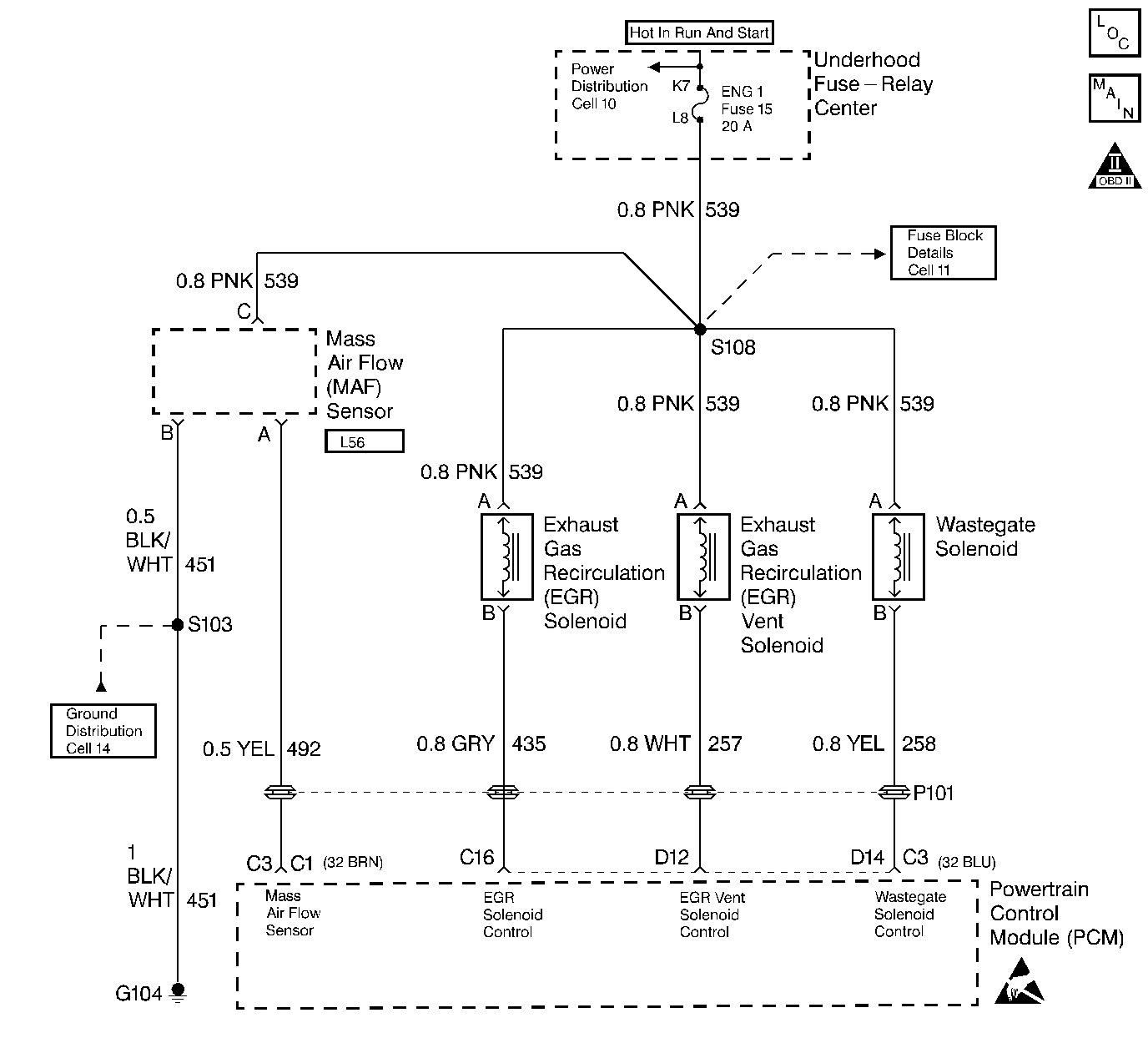
Circuit Description
The EGR flow is controlled by the vacuum actuated EGR valve. The EGR vent solenoid purges to atmosphere the vacuum level at the EGR valve actuator as commanded by the PCM. This is done when the EGR flow is desired to turn off quickly. When the PCM is commanding the EGR vent ON, the voltage potential of the circuit will be low (near 0 volts). When the PCM is commanding the EGR vent OFF, the voltage potential of the circuit will be high (near battery volts). The primary function of the PCM in this circuit is to supply the ground for the EGR vent solenoid. This is a type B code.
Conditions for Setting the DTC
| • | PCM requested EGR vent ON. |
| • | Voltage on EGR vent control circuit high (near battery volts). |
| • | Conditions met for 2 seconds. |
or
| • | PCM requested EGR vent solenoid OFF. |
| • | Voltage on EGR vent control circuit low (near 0 volts). |
| • | Conditions met for 2 seconds. |
Action Taken When the DTC Sets
The MIL will be illuminated after 2 test failures.
Conditions for Clearing the MIL/DTC
| • | The PCM will turn the MIL off after three consecutive trips without a fault condition. |
| • | A History DTC will clear when forty consecutive warm-up cycles that the diagnostic does not fail (coolant temperature has risen 5°C (40°F) from start up coolant temperature and engine coolant temperature exceeds 71°C (160°F) that same ignition cycle. |
| • | Use of a Scan Tool |
Diagnostic Aids
The scan tool has a 5 second ON time abort. The EGR vent solenoid can be commanded ON for as many times as needed, in 5 second intervals. Its possible other EGR DTCs may set along with DTC P1653. This diagnostic can be checked at key up. A quick operational check can be made by commanding the EGR vent solenoid ON and OFF with the scan tool while monitoring Actual EGR. Actual EGR will display BARO (approximately) when EGR solenoid is OFF.
The Adaptive Learn Matrix (ALM) is used to adjust the EGR vacuum control based on Mass Air Flow (MAF). The ALM may change as a result of back pressure increases over the life of the vehicle or other engine system variations. The ALM is made up of sixteen cells (numbered from zero to fifteen) in which each cell covers a range of engine speed (RPM) and load (mm3).
An intermittent may be caused by the following:
| • | Poor connections. |
| • | Rubbed through wire insulation. |
| • | Broken wire inside the insulation. |
Test Description
Number(s) below refer to the Step number(s) on the Diagnostic Table.
-
Be sure that both the ON and OFF states are commanded. Repeat the commands as mant times as necessary.
-
This check can detect a partially shorted coil which would cause excessive current flow. Leaving the circuit engerized for 2 minutes allows the coil to warm up. When warm, the coil may open (Amps drop to 'zero', or short (Amp draw greater than 0.75A).
-
If no trouble is found in the control circuit or the connection at the PCM, the PCM may be malfunctioning, however, this is an extremely unlikely failure.
Step | Action | Value(s) | Yes | No |
|---|---|---|---|---|
1 |
Important: Before clearing DTCs use the scan tool Capture Info to record freeze frame and failure records for reference, as data will be lost when Clear Info function is used. Was the Powertrain On-Board Diagnostic (OBD) System Check performed? | -- | ||
Does the solenoid turn ON and OFF (audible "click") with each command? | -- | |||
Is current draw less then the specified value, but not zero? | 0.75 A | |||
4 |
Does DVM display infinite resistance? | -- | ||
5 |
Does test light turn ON and OFF with each command? | -- | ||
6 |
Is the test light ON? | -- | ||
7 |
Does the solenoid operate (audible "click")? | -- | ||
8 | DTC is intermittent. If no additional DTCs are stored, refer to Diagnostic Aids. If additional DTCs were stored refer to the applicable DTC table(s) first. Are any additional DTCs stored? | -- | Go to the Applicable DTC Table | Go to Diagnostic Aids |
9 | Check for a poor connection at the EGR Vent solenoid and replace terminals as necessary. Did the terminals require replacement? | -- | ||
10 | Repair EGR Vent solenoid control circuit. Is the action complete? | -- | -- | |
11 | Check for a poor connection at the PCM and EGR Vent solenoid. Was a problem found? | -- | ||
12 | Repair the open in the ignition feed circuit. Is the action complete? | -- | -- | |
13 | Replace the EGR Vent solenoid. Is the action complete? | -- | -- | |
Replace the PCM. Important: The new PCM must be programmed. Refer to Powertrain Control Module Replacement/Programming . Is the action complete ? | -- | -- | ||
15 |
Does the scan tool indicate that this diagnostic Passed? | -- | ||
16 | Using the scan tool, select Capture Info, Review Info. Are any DTCs displayed that have not been diagnosed? | -- | Go to the Applicable DTC Table | System OK |
